European election turnout: mandatory voting, age limits and possibility to choose candidates
Pod črto have analysed the systemic reasons why almost one in two Europeans chooses not to vote.

When it comes to non-participation in elections, Slovakia topped the list in the 2019 European Parliament elections, with 77% of eligible voters not participating, followed by Czechia, Slovenia, Croatia, and Portugal in that order. In Slovenia, as many as 71 per cent of eligible voters chose not to participate in 2019.
A voter, as a term, can signify either a person who has the right to vote in an election or a person who actually votes. In this article, we will use the term ‘voter’ to refer to the person who can choose whether or not to participate in an election.
Low voter turnout means that the lives of the majority of a country’s population and, in the case of European Parliament elections, the lives of people in other European countries, are affected by the decisions of a small minority of the population. If the number of voters from certain social groups or regions is particularly low, this also means that there is an unequal representation in important social and political decisions. On the other hand, it raises the question of the legitimacy of those in power, which is why countries seek systemic measures to increase participation in elections.
Slovenia is no exception when it comes to low turnout in European elections: in the last European Parliament elections, almost one in two eligible voters decided not to vote.
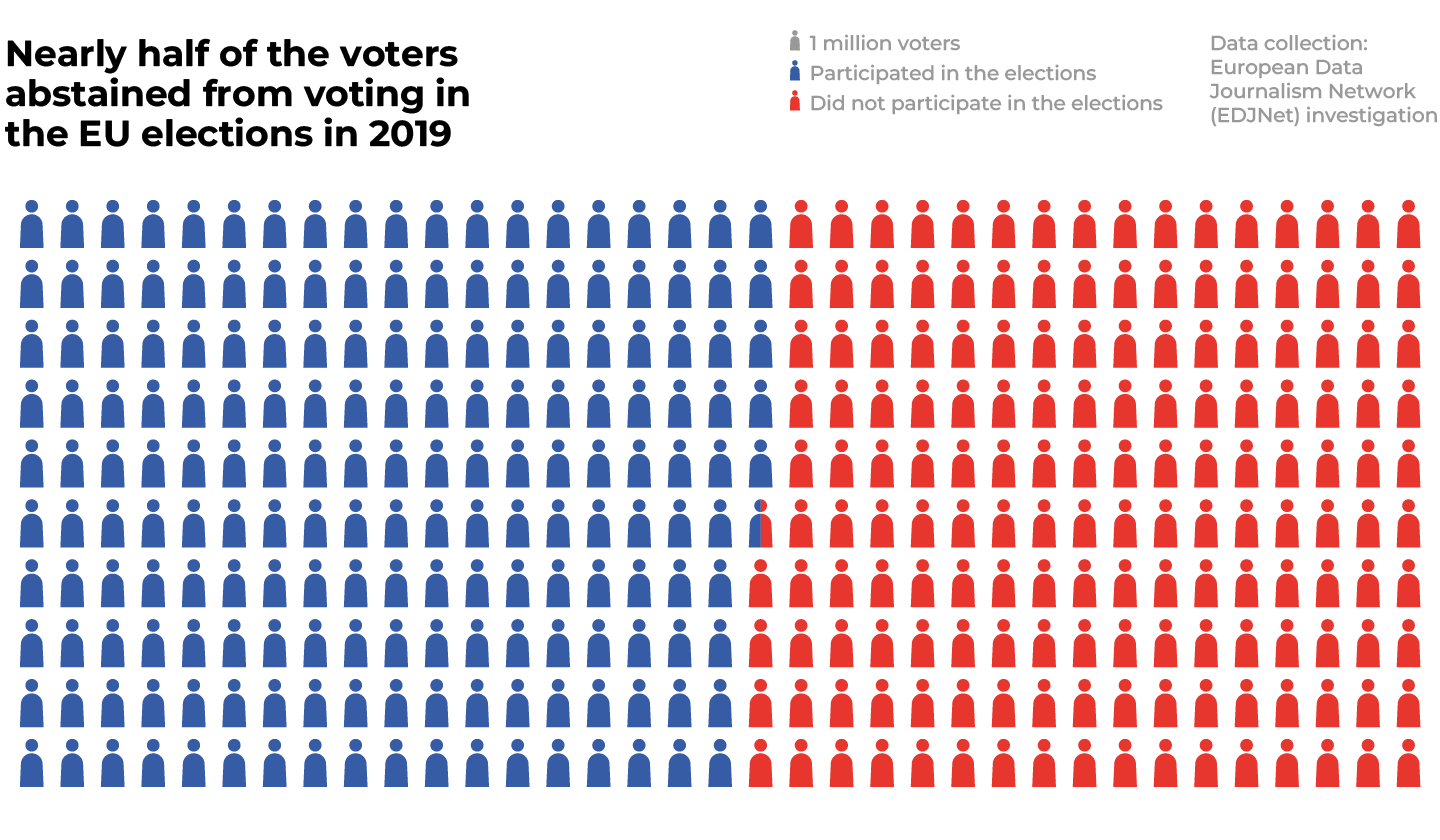
As part of the European Data Journalism Network (EDJNet), Pod Črto worked with 17 other European media outlets in a large-scale data project to collect data on voter turnout in all EU countries for national, local, and European elections.
In a series of articles to be published in the coming weeks, we have prepared an in-depth analysis for which we have collected additional data on voters’ personal characteristics, as well as on socio-economic factors, the electoral context and systemic factors that may influence turnout. In this context, we have paid particular attention to the different electoral arrangements in European countries.
In our analyses, we have focused on the types of elections with the lowest turnout in Slovenia – local and European elections. The European elections have the lowest number of voters in Slovenia, so we looked at them first. The analysis covers the 2009, 2014 and 2019 European Parliament elections.
The case of Slovenia: Less than a third of voters participate in European elections

unnamed (2)
A polling station in Ljubljana. Photo: Metod Blejec
In Slovenia, voter turnout has declined in most elections since the 1990s. The change in turnout in the super election year 2022 occurred in presidential and especially national elections, while turnout in local elections decreased.
However, turnout in all European elections in Slovenia has so far been even lower than in local elections.
In all the years of Slovenia’s membership since 2004, less than a third of the electorate took part in the European elections. This means that, on average, more than 1,200,000 voters in Slovenia do not participate in the election of MEPs. In other words: the average non-participation in European elections in Slovenia exceeds the average participation in national elections.
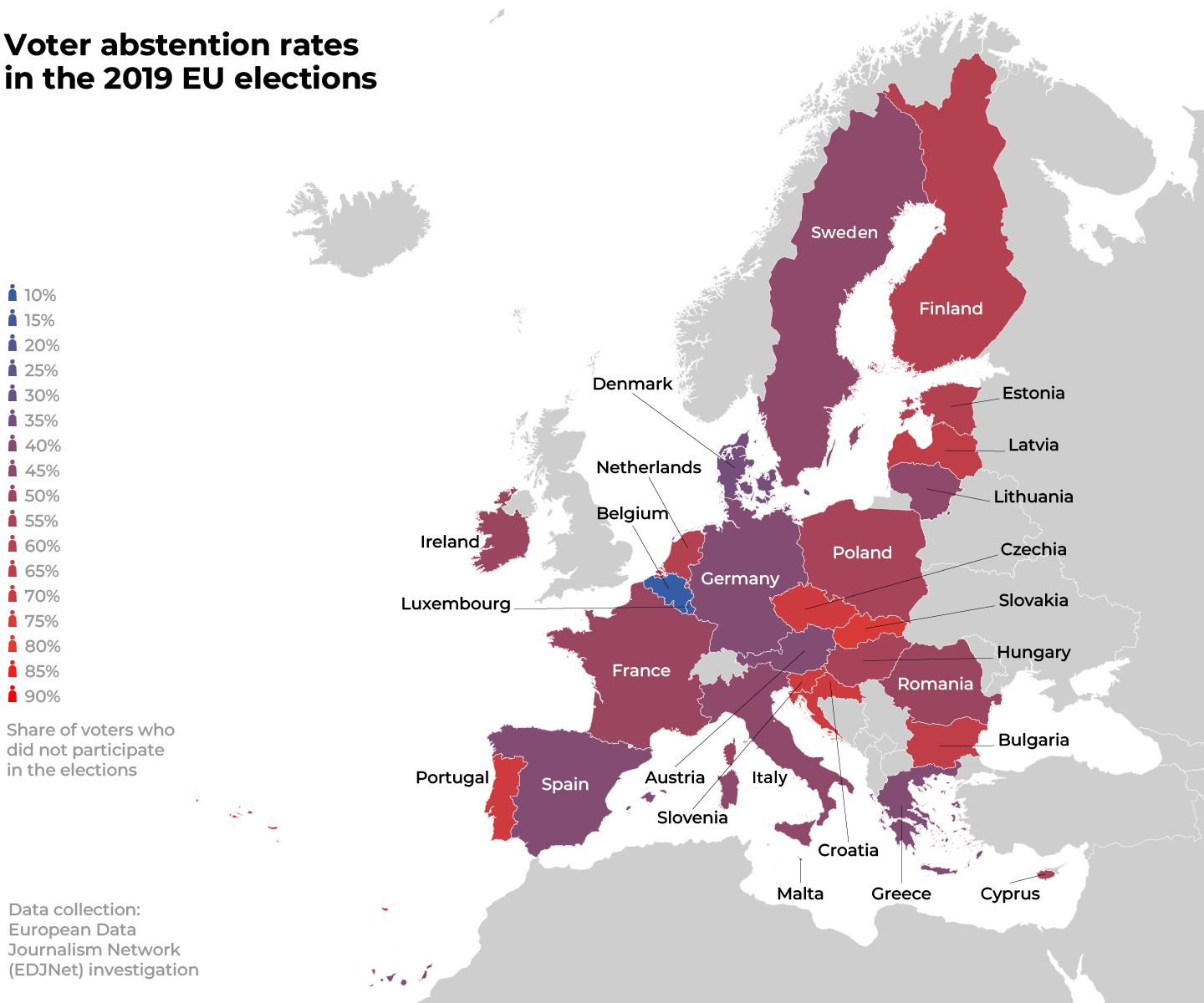
Looking not only at the most recent elections, but also at the average turnout in the last three European Parliament elections, Slovenia is among the top six countries with the lowest average turnout in the last three European elections, i.e. in 2009, 2014 and 2019.
Slovakia ranks first in terms of non-participation, with an average of more than 80% of voters not participating in the last three European Parliament elections. It is followed by Czechia, Croatia, Slovenia, Poland, and Portugal.
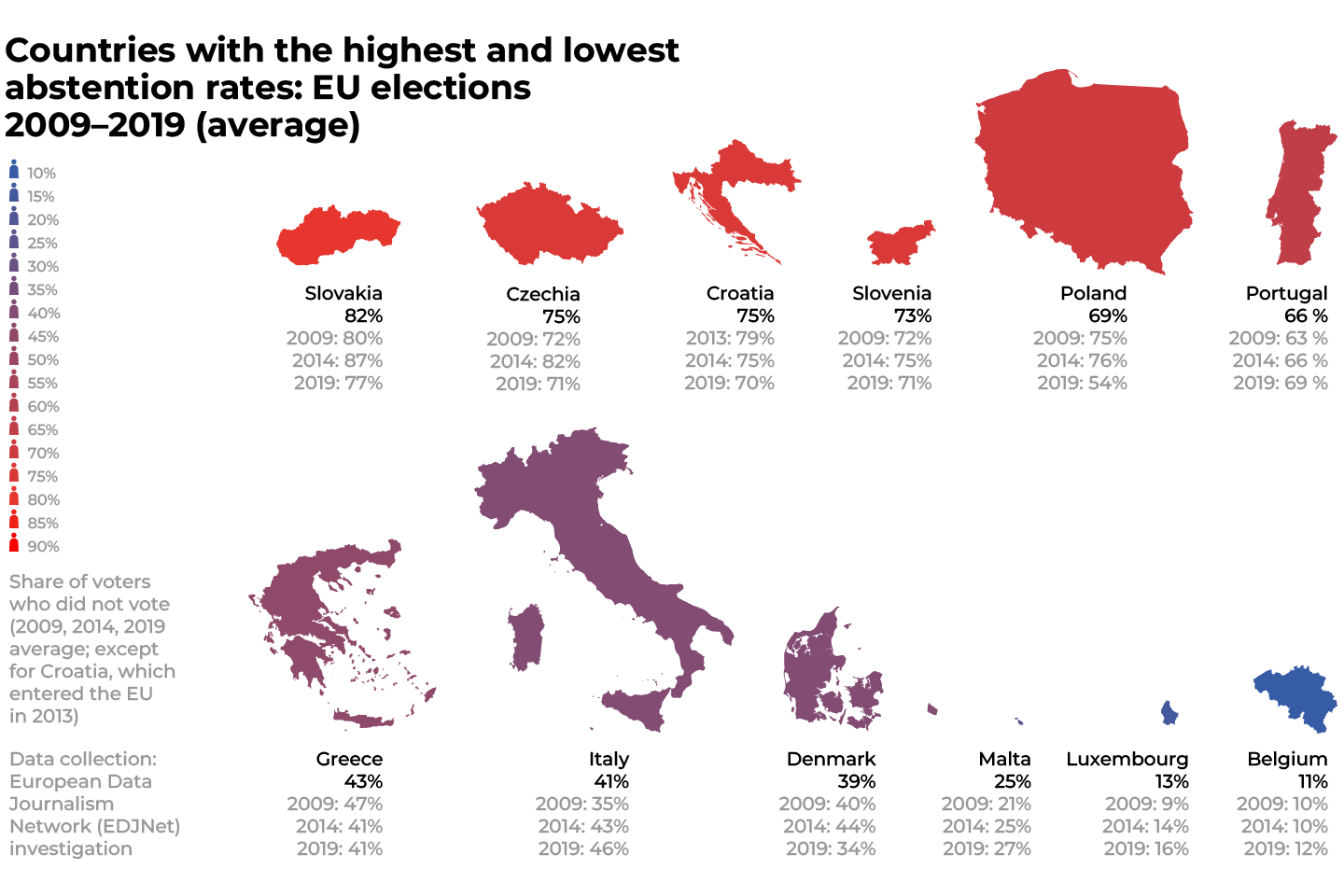
Non-participation higher in newer EU Member States
The first direct elections to the European Parliament were held in 1979. In cooperation with other EDJNet members, we have been able to collect data for all elections for most countries (with the exception of Luxembourg, for which some data is missing).
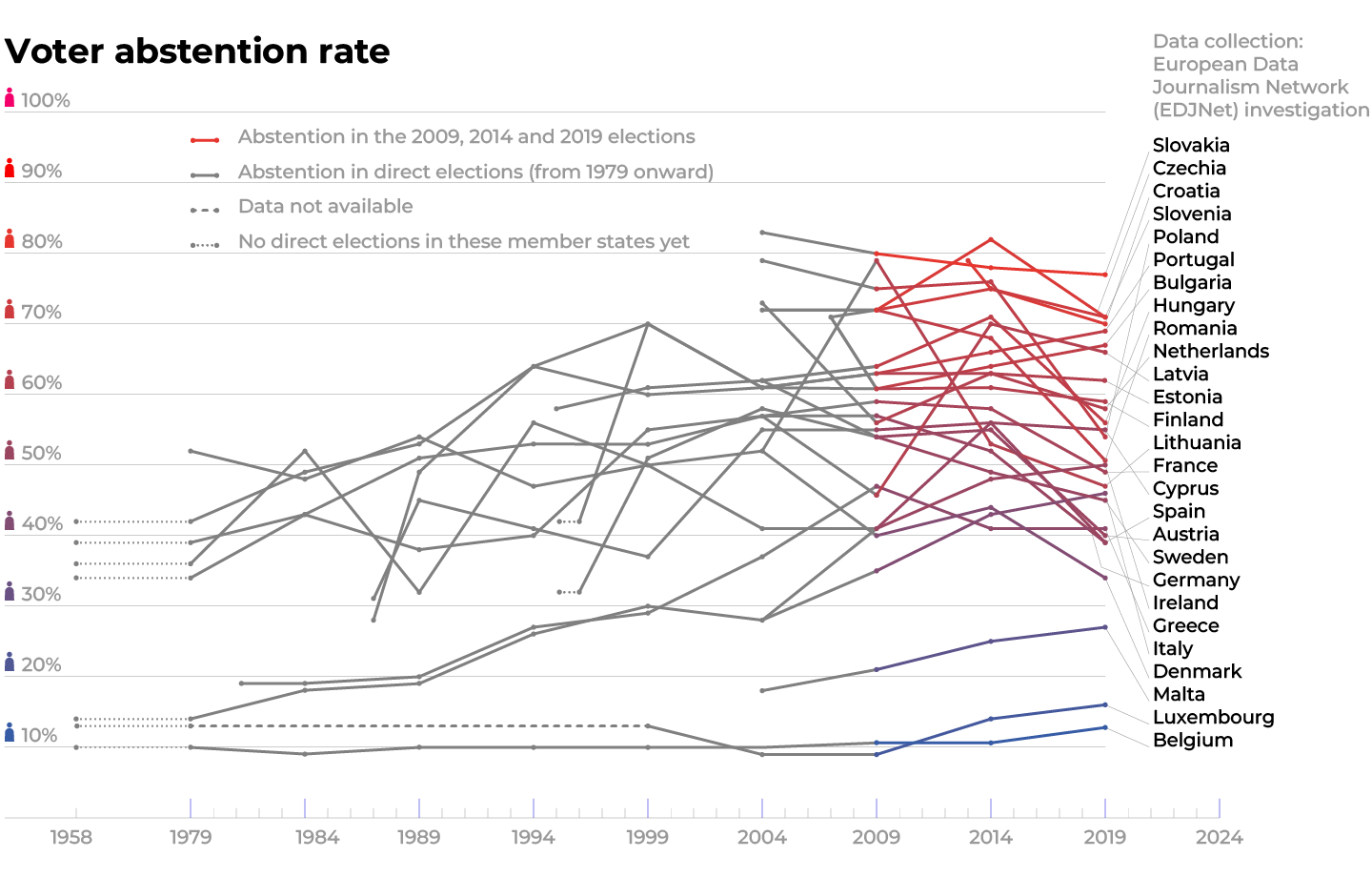
As Dr Alenka Krašovec from the Faculty of Social Sciences in Ljubljana explained, the argument that European elections are second-class compared to national elections was already put forward by researchers when the first direct elections to the European Parliament were held in 1979. This argument was based on the lower voter turnout in the Member States at that time compared to the turnout in national elections in those countries, and this trend has been confirmed in practice today. Basically, voters and political parties see some elections as more important than others, and European elections are often perceived as less important in this respect, Dr Krašovec explained.
Interestingly, however, the powers of the European Parliament have been increasing over the decades, which might be expected to increase voter turnout, Dr Krašovec added.
Based on the data collected on voter turnout, Pod črto sought to answer the question of what factors might influence the proportion of eligible voters who actually go to the polls. We focused on two aspects: systemic and contextual factors on the one hand, and voters’ personal characteristics and socio-economic factors on the other.
Electoral systems: mandatory voting, age limits and preferential voting
As it would be impossible to collect data for all years of direct elections to the European Parliament, we have focused on the 2009, 2014 and 2019 elections. The exception is Croatia, which was not yet a member of the EU in 2009. It held its first European elections in 2013, immediately after joining the European Union, and then another one the following year, in 2014, along with all other EU members.
We used available official sources and verified the collected data separately with each country’s representations and relevant institutions.
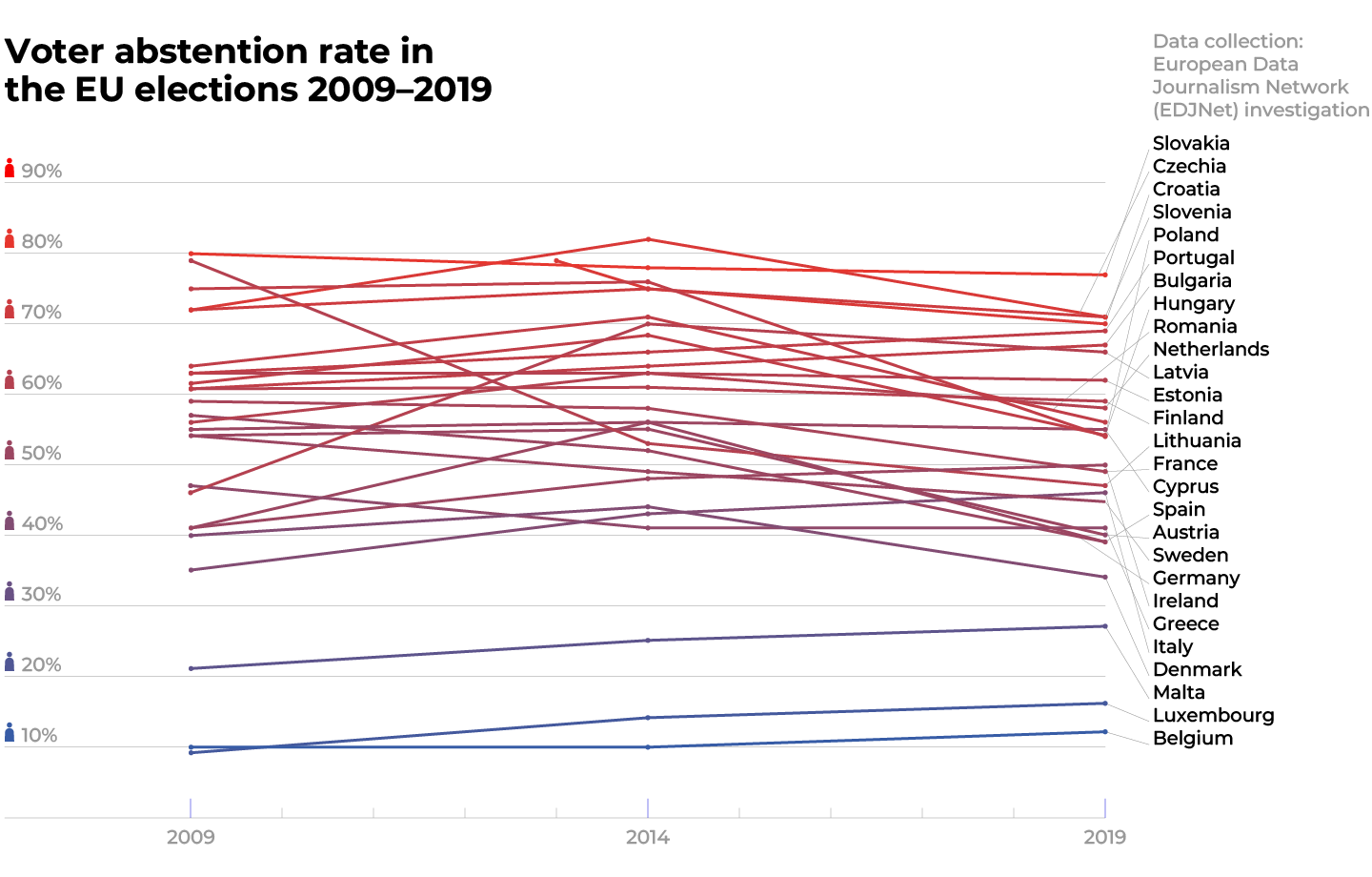
Among the systemic factors, we focused on data on the electoral system, while among the contextual factors, we focused on the duration of membership in the European Union and the setting of each country in geographical sub-regions.
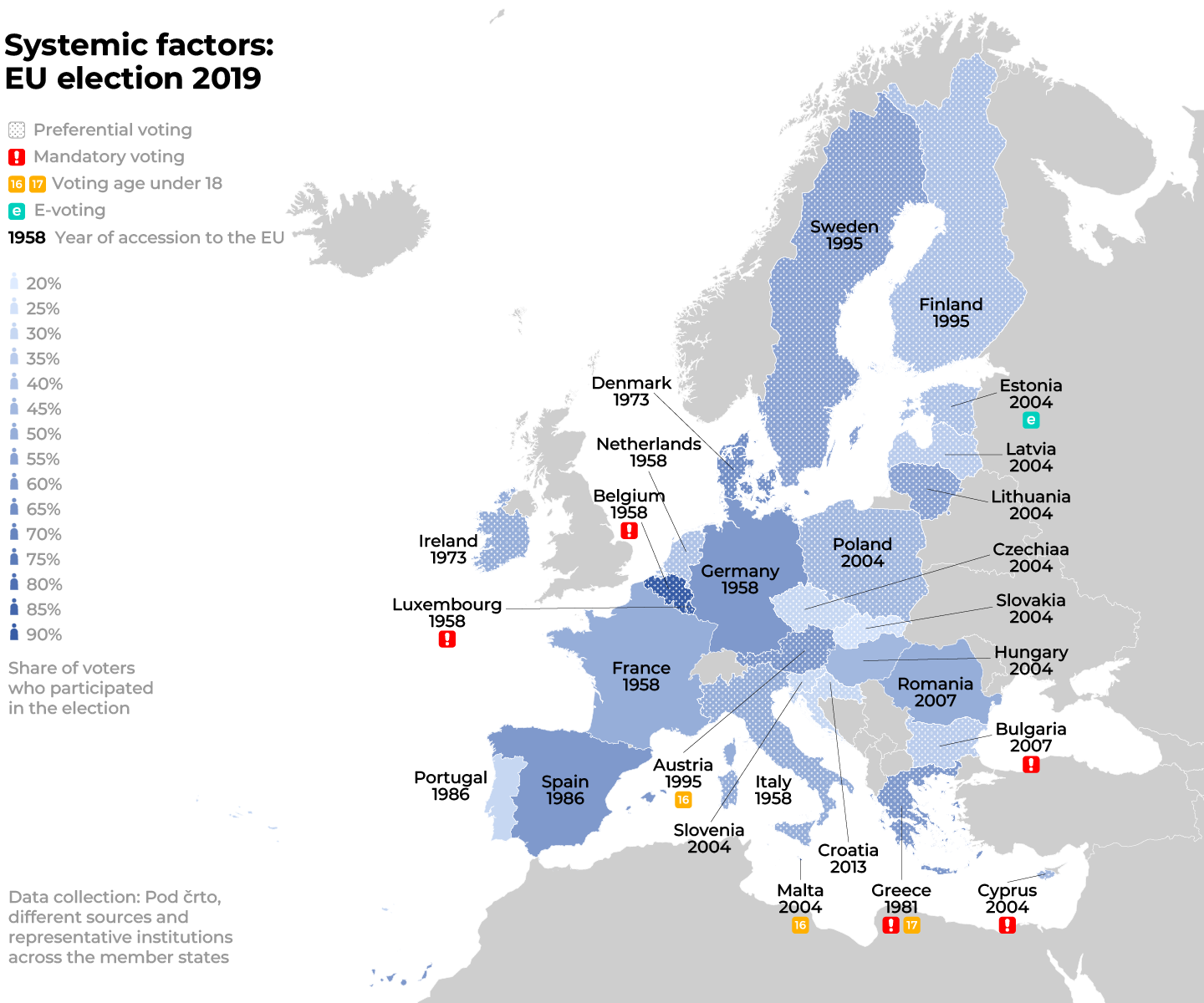
We collected and verified data on the last three European Parliament elections, i.e., which EU countries offered a direct choice between candidates, and which had an age limit below 18, compulsory participation and e-voting (this type of voting was only possible in Estonia).
In the case of the 2019 elections, Belgium, Bulgaria, Cyprus, Greece, Luxembourg, and Cyprus had compulsory voting at the time.
Both Luxembourg and Belgium, which have compulsory voting, have the highest turnout in European elections of all EU countries.
The case of Belgium and Luxembourg: Mandatory voting
We contacted the Belgian EP office to find out what compulsory participation means in practice in Belgium and what the possible sanctions are for non-participation in elections. We were told that the penalty for an absence without justification is firstly financial, between €40 and €80 for a first absence and between €80 and €200 for a second absence. If a voter fails to vote four or more times in a fifteen-year period without a valid reason, they will be removed from the electoral register for ten years. During this period, they cannot be appointed to public office or receive honours.
The Luxembourg EP office also confirmed that participation in elections is compulsory in Luxembourg, and that, according to their law, absenteeism without a valid reason can also be punished by a fine.
An interesting example is Bulgaria, where participation was not compulsory in the 2009 and 2014 European Parliament elections but was compulsory for the first time in the 2019 European elections.
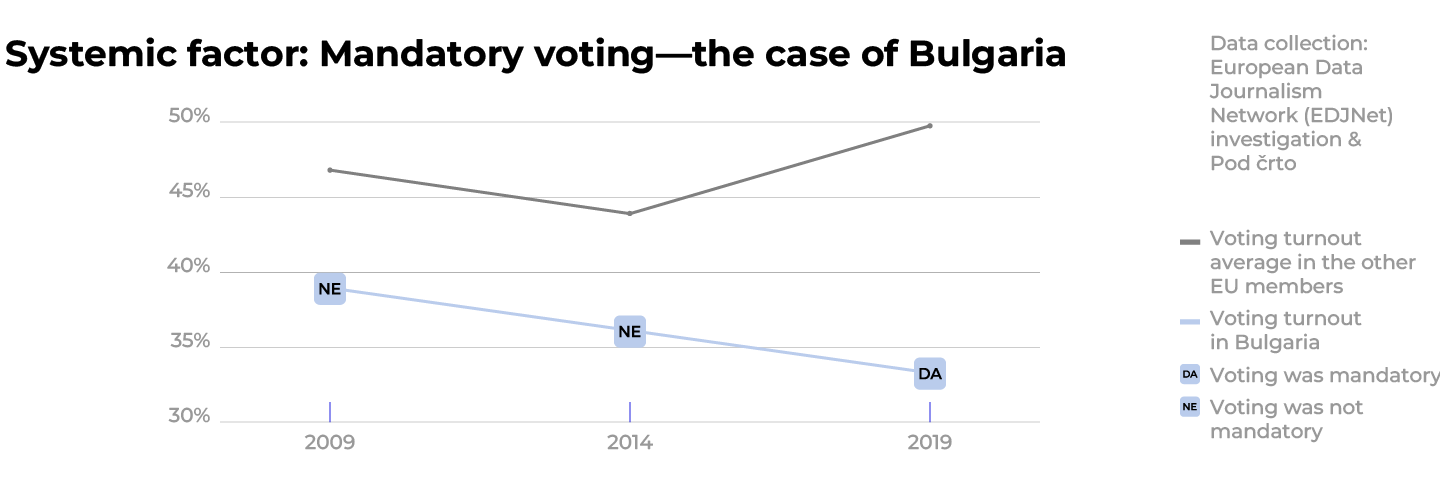
We were told by the Bulgarian EP office that, although participation in elections has indeed been compulsory in Bulgaria since 2016, there is no penalty for non-participation. This probably explains why turnout has not increased despite the obligation, but not why it has decreased. The answer to this question will have to be found among other contextual, systemic, and socio-economic factors, which will be discussed in more detail in the next article.
Why have compulsory voting at all, which has been introduced in a minority of EU countries? As Dr Krašovec explains, the most common justification is that it is an attempt to achieve better representation in parliament. The logic behind this is that it will result in more people expressing their desire or preference and thus prevent parts of the population from being left out of the decision-making process.
In our analysis, we also included the question of whether the country’s electoral system allows voters to choose only between lists or whether they can also choose a candidate directly, which we defined as the possibility to choose. This option includes preferential voting, which is also available in Slovenia for the European Parliament elections. The preferential vote can be relative or absolute, compulsory or optional for the voter, while some countries select candidates through a single transferable vote system.
A relative preferential vote means that a certain condition must be met in order for preferential votes to be taken into account in the allocation of seats, Dr Krašovec explains.
Varying participation in European regions
The contextual factors we have included in the analysis are also the length of each country’s membership of the EU and its geographical location. To classify countries into European regions, we used the EvroVoc division into Central and Eastern Europe, Northern Europe, Southern Europe and North-Western Europe, which is also used by the European Parliament.
For each region, we calculated the average voter turnout based on the turnout of all the countries in the region. As can be seen, there is a marked difference in turnout between the countries of North-Western Europe and Central and Eastern Europe.
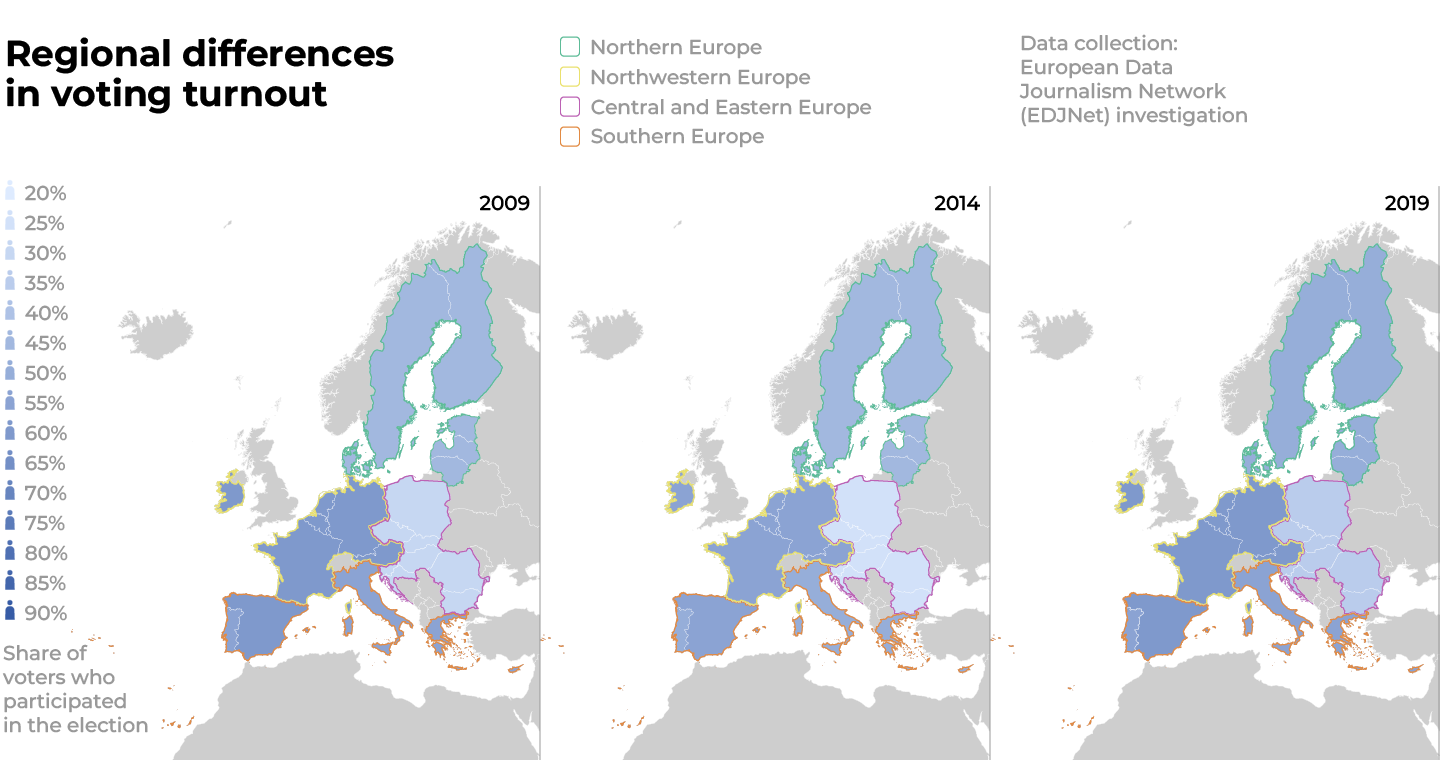
As can be seen from the map, voter turnout in European elections is lower in the newer EU member states. in the new member states of the European Union, which joined in 2004 or later, fewer voters take part in the elections.
“In the 1990s, or rather in the late 1980s and early 1990s, the new member states of the European Union were establishing democracy, some from scratch, some once again,” said Dr Alenka Krašovec, commenting on the context. “Another question, of course, is to what extent the countries that joined the European Union in 2004 or later have managed to identify with the European level or European politics,” Dr Krašovec added.
Dr Marko Hočevar, from the Faculty of Social Sciences in Ljubljana, pointed out that in addition to the factors influencing the different levels of participation in elections between regions, inequality has also increased significantly in these societies: “The year 2004, for example, was presented as a major event in these countries. Okay, let’s be patient for a while. We are joining this select club of developed democracies, in quotes, and things will sort themselves out. What has happened is that in many places this has not only not been confirmed at all, but the opposite has been the case. Especially since in these countries – in these countries and in the world in general – the crisis of 2008, 2009 was about to happen.”
He added: “We joined the European Union. The idea was that everything would be better. Then the crisis came, and it was actually worse than before, right. Since then, and during that time, the European Union has absolutely not shown itself to be an institution of social solidarity that understands the needs and interests of the Greek, or the Portuguese, for example. People were, of course, quite resigned and disillusioned, which is logical.”
The case of Slovakia and predictions for this year’s elections

unnamed (3)
A polling station in Ljubljana. Foto: Metod Blejec
Although Slovakia had the lowest voter turnout in Europe in the last European elections, the trend was positive. In fact, turnout increased from 13.1 per cent to 22.7 per cent. Slovakia still ranks first among EU countries in terms of non-participation in 2019, but most countries show a positive trend compared to previous elections.
“It was expected that the far-right, extremist, Eurosceptic and populist parties would be strengthened in the 2019 elections,” Dr Olga Gyárfášová from Comenius University in Bratislava told us when we asked about the context of this trend. The expectation was justified: “Important shifts occurred between 2014 and 2019 – the British voted for Brexit in the referendum, the so-called migrant crisis in 2015 strengthened anti-EU parties, especially in Italy (Lega), Germany (AfD) and some Central and Eastern European countries, Eurosceptics were in power (for example in Hungary and Poland), and in Slovakia, a far-right party with strong anti-EU policies entered the parliament in 2016.” According to Gyárfášová, the higher turnout is also linked to the mobilisation of younger voters, who are interested in environmental protection, healthcare, and food quality in Europe.
Rapid changes in turnout that are not related to systemic factors, such as changes in the electoral system, or to socio-economic factors, where changes tend to be slow (except in crisis situations), are related to contextual factors – for example, the perception that a particular election represents a critical, tipping point.
“In the case of this year’s elections, the emphasis is on the criticality of the elections, on deciding important things,” said Dr Krašovec. ”There is more talk about the elections, there were more information campaigns, and in Slovenia we also had the simultaneity of decision-making, as the European elections were combined with several referendums, which again means an additional aspect of mobilisation,” said Dr Krašovec, summarising the contextual factors that could influence a higher turnout in this year’s European elections.
In the next article, we will present the results of our analysis of the European elections, and then we will focus on the elections in Slovenia.
Original source: https://podcrto.si/evropske-volitve-slovenija-v-samem-vrhu-po-neudelezbi/
